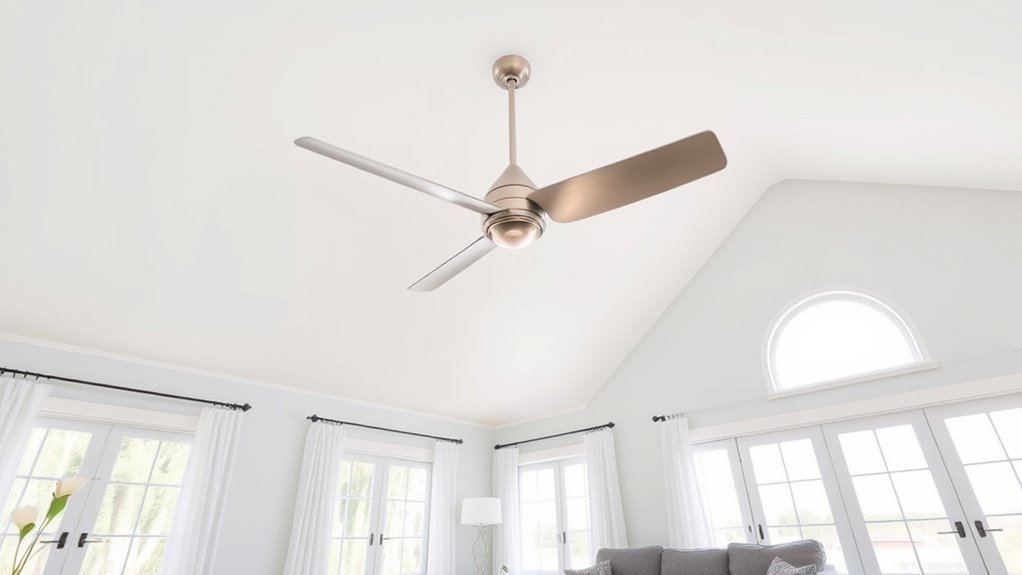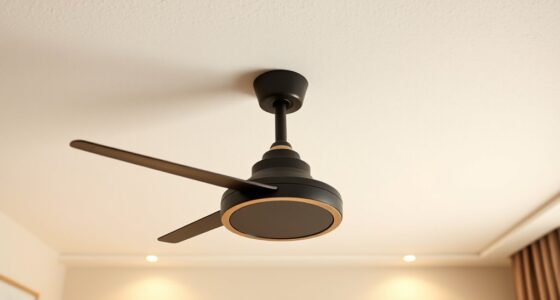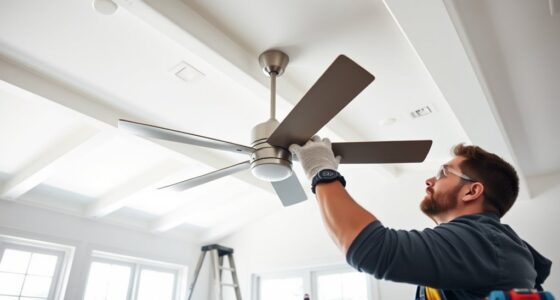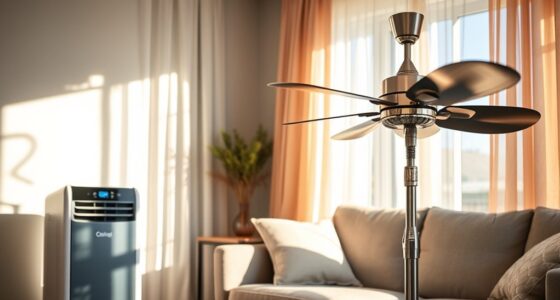To choose the right ceiling fan size, start by measuring your room’s length and width to find the square footage. For smaller rooms up to 75 sq ft, select fans with a 29–36 inch diameter, while larger spaces need bigger fans, up to 54 inches or more. Consider ceiling height, airflow needs, and whether you want quiet operation or extra features. Keep safety clearances in mind for ideal performance. If you’re curious about matching fans to specific spaces, there’s more to explore below.
Key Takeaways
- Measure your room’s length and width to determine the square footage for appropriate fan sizing.
- Match the fan diameter to room size: 29–36 inches for up to 75 sq ft, up to 54 inches for over 226 sq ft.
- Consider ceiling height; use flush mounts for low ceilings and downrods for higher or vaulted ceilings.
- Ensure at least 7 feet of clearance from the floor and 8–10 inches between blades and ceiling for safety and airflow.
- Choose a fan with suitable CFM ratings that match your room’s size and intended use for effective circulation.
Determine Your Room Size and Corresponding Fan Diameter

To choose the right ceiling fan size, start by accurately measuring your room’s dimensions. Measure both the length and width in feet, then multiply these numbers to find the square footage. This total helps you determine the appropriate fan diameter. For example, a room up to 75 sq ft needs a fan between 29 and 36 inches. Rooms from 76 to 144 sq ft should have fans between 36 and 42 inches, while spaces 145 to 225 sq ft require fans of 44 to 50 inches. Larger rooms, over 226 sq ft, need fans from 50 to 54 inches, or multiple fans for areas exceeding 400 sq ft. Keep in mind the room’s shape and function, as these factors influence the ideal fan size for suitable airflow and comfort. Proper fan sizing improves airflow and energy efficiency. Incorporating creative problem-solving techniques can also help optimize your fan choice if the room has unusual dimensions or architectural features.
Consider Ceiling Height and Mounting Options

Ceiling height plays an essential role in choosing the right ceiling fan and mounting method. If your ceiling is 8 feet or lower, a flush mount or hugger-style fan keeps blades at a safe height and maximizes airflow. For ceilings above 8 feet, a downrod helps position blades 8 to 10 inches below the ceiling, enhancing efficiency. Taller ceilings, like vaulted ones, may require longer downrods to keep fans within effective airflow range. Proper installation ensures optimal performance and safety for your ceiling fan.
Match Fan CFM and Airflow to Room Dimensions
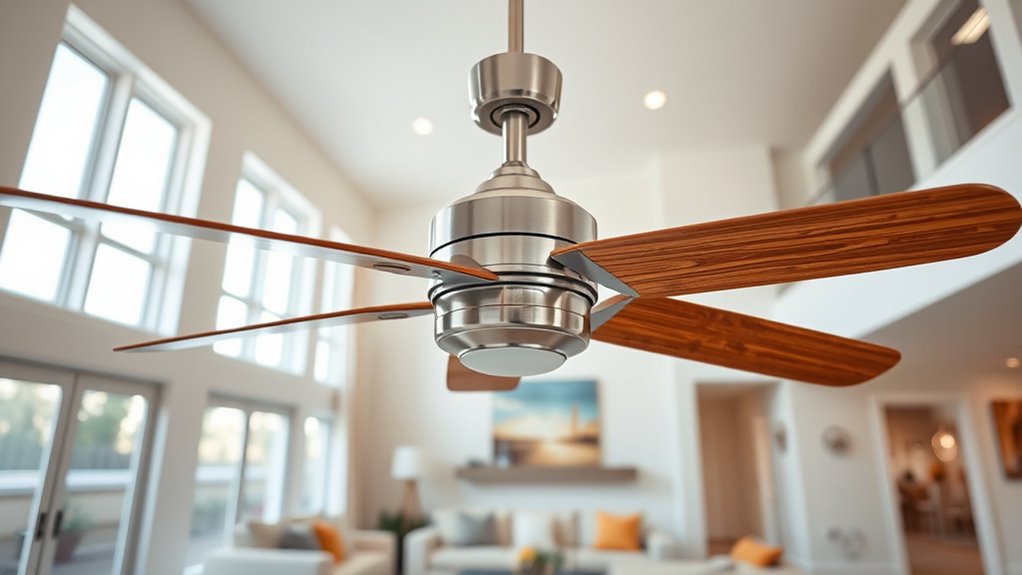
To guarantee your ceiling fan works efficiently, you need to match its CFM output to your room’s size. A fan with too little airflow won’t circulate air well, while an oversized fan might create discomfort. By understanding the CFM performance indicators, you can choose a fan that provides ideal comfort and energy efficiency for your space. Additionally, considering the advanced technology and design features of modern fans can enhance airflow and overall performance.
Room Size Compatibility
Matching the fan’s airflow capacity, measured in CFM, to your room’s size guarantees effective cooling and air circulation. Use the room’s square footage to determine the right fan size and airflow needs. Larger rooms need fans with higher CFM or multiple fans for proper coverage. Here’s a quick guide:
| Room Size (sq ft) | Recommended Fan Size | Typical CFM Range |
|---|---|---|
| Up to 75 | 29–36 inch fans | 4,000–6,000 |
| 76–144 | 36–42 inch fans | 6,000–10,000 |
| 145–225 | 44–50 inch fans | 10,000–15,000 |
| 226–400 | 50–54 inch fans | 15,000–20,000 |
| Over 400 | 56–60+ inch fans or multiple fans | 20,000+ |
Matching airflow to room size guarantees efficient cooling and prevents draft issues. Additionally, considering the room’s shape and ceiling height can influence the optimal fan size for maximum comfort.
CFM Performance Indicators
Understanding how CFM ratings translate to room size is essential for selecting an effective ceiling fan. Typically, smaller rooms up to 97 square feet need fans with around 4,000 CFM for proper airflow. Medium-sized spaces, between 97 and 194 square feet, benefit from fans moving 4,000 to 6,000 CFM, while larger rooms over 194 square feet often require 6,000 to 8,000+ CFM to circulate air effectively. For standard 8-foot ceilings, fans rated between 4,000 and 5,000 CFM work well. Keep in mind, higher CFM ratings usually mean stronger airflow, but energy efficiency standards matter too. Matching the CFM to your room’s size guarantees comfort without excessive wind, improving overall air circulation and energy efficiency.
Select Fans Based on Room Function and Usage

Choosing the right ceiling fan depends on the specific function and usage of each room. For bedrooms, prioritize fans with quiet operation to avoid sleep disruption. Living rooms benefit from fans that balance airflow and visual appeal as focal points. Kitchens require humidity-resistant fans with motor protection to handle grease and moisture. Bathrooms need compact, moisture-resistant fans suitable for small spaces. Offices should have fans that provide steady airflow without drafts to maintain comfort during work. Proper fan size is essential to ensure optimal airflow and energy efficiency in each space. Fans in bedrooms should be quiet and energy-efficient. Living rooms need a balance of airflow and aesthetics. Kitchens require moisture-resistant, durable fans. Bathrooms benefit from small, moisture-proof fans. Offices need steady, draft-free airflow. Ensuring the fan’s size matches the room’s specific function and usage helps maximize comfort and efficiency.
Evaluate Blade Span and Noise Levels for Comfort
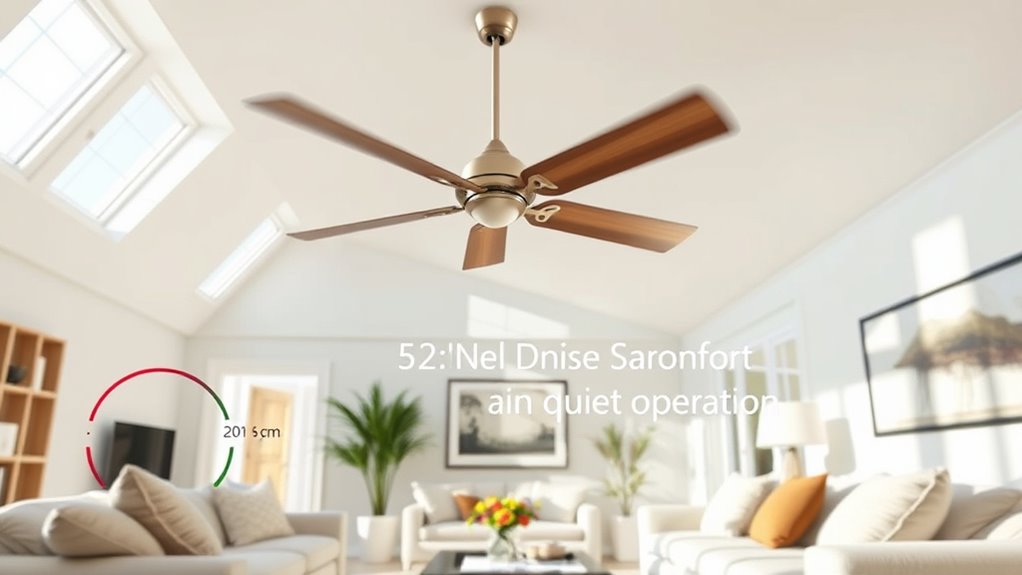
When choosing a ceiling fan, it’s important to take into account how blade size impacts airflow and noise. Larger blades move more air quietly, while smaller blades may require higher speeds that can increase noise and vibration. Finding the right balance ensures your fan cools effectively without causing discomfort or excess sound. Properly sized blades also help minimize vibrations, contributing to a quieter and more comfortable environment. Additionally, selecting a fan with appropriate suction power and cleaning modes can ensure efficient operation while maintaining a peaceful atmosphere.
Blade Size and Airflow
Selecting the right blade size is essential for achieving ideal airflow and noise levels in your space. Larger blades sweep more air, making them perfect for bigger rooms, while smaller blades suit compact areas. For rooms under 50 sq. ft, 600-900mm blades work well; medium rooms need around 1200mm blades; larger spaces may require up to 1400mm or multiple fans. Keep in mind:
- Longer blades cover more area, improving air circulation
- Blade pitch influences how much air is moved per rotation
- Steeper pitches push more air but need stronger motors
- Blade shape affects airflow direction and efficiency
- Material impacts weight, spin speed, and motor load
- Blade material can influence noise levels and durability, contributing to overall comfort
Choosing the right blade size guarantees your fan circulates air effectively without excessive noise or strain, enhancing comfort in your room.
Noise Level Considerations
Blade span directly influences both airflow and the noise produced by a ceiling fan. Larger blade spans can boost airflow but may also generate more noise if not aerodynamically optimized. More blades tend to increase turbulence, leading to higher noise levels, especially at higher speeds. Blade shape also matters; circular-arc blades are typically quieter than flat-plate designs because they reduce turbulence. Rotational speed impacts noise too—faster spins create more aerodynamic noise. To minimize sound, choose fans with optimized blade shapes and fewer blades if possible. Proper installation and materials that dampen vibrations help keep noise levels low. Measuring sound pressure levels (SPL) and adhering to standards like AMCA guarantees your fan operates quietly, balancing comfort and performance effectively. Additionally, understanding supermarket hours today can help you plan shopping trips around quieter hours to avoid noise and crowds.
Balance and Vibration
Longer blades can enhance airflow but also increase the risk of vibration if not properly calibrated, which can compromise comfort. To maintain a smooth operation, you need to evaluate blade span and noise levels carefully. Proper balance is essential, especially with larger blades, as imbalance can cause motor strain and wobbling. Factors influencing vibration include blade material, construction quality, and correct installation. Keep these points in mind:
- Match blade span to room size for efficient airflow
- Ensure blades are balanced and free of defects
- Use high-quality balance grades for sensitive environments
- Regularly clean blades and check for looseness
- Avoid overextending the motor beyond its capacity
- Consider tire size compatibility when selecting blades to ensure optimal balance and reduce vibration
Balancing your fan prevents vibrations, reduces noise, and prolongs lifespan, ensuring consistent comfort.
Choose Fan Style and Aesthetic to Complement Your Space

Choosing a fan style that complements your space starts with understanding the overall design theme and atmosphere you want to create. If you prefer a cozy, rustic vibe, opt for fans with natural wood finishes, distressed details, or a mix of wood and metal to evoke warmth and heritage. For a sleek, modern look, select fans with clean lines, minimalist blades, and neutral colors like black, silver, or white, often featuring smart technology. Industrial fans with exposed hardware and dark metals suit urban or loft spaces, while tropical or outdoor fans with broad blades and lightweight materials evoke beachy, relaxed environments. Always match the fan’s style to your décor, considering finishes, materials, and details to guarantee harmony and enhance your room’s aesthetic.
Account for Outdoor or Covered Area Requirements
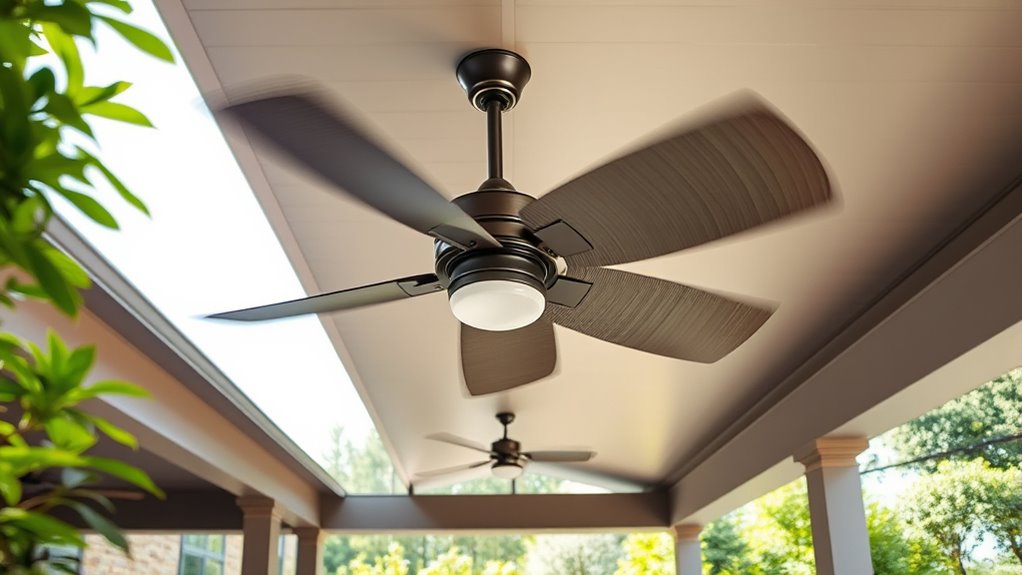
How you size your outdoor ceiling fan depends heavily on the specific area it will serve. For small patios up to 75 sq ft, a fan with a 29-36 inch diameter works well. Medium spaces, 76-144 sq ft, need fans with 36-42 inch blades. Larger areas, 145-225 sq ft, require 44-50 inch fans, while areas over 225 sq ft benefit from fans larger than 50 inches. For very large patios (200-400+ sq ft), consider 56-60 inch fans or multiple units for even airflow. Measuring the space accurately is crucial to selecting the correct fan size, ensuring optimal airflow and comfort.
Key points to remember:
- Larger outdoor areas need bigger fans or multiple units
- Open patios require more airflow than enclosed ones
- Wind and weather can influence fan performance
- Fans should be rated for outdoor use to withstand moisture
- Proper sizing guarantees comfort and efficiency
Ensure Proper Clearance for Safety and Efficiency
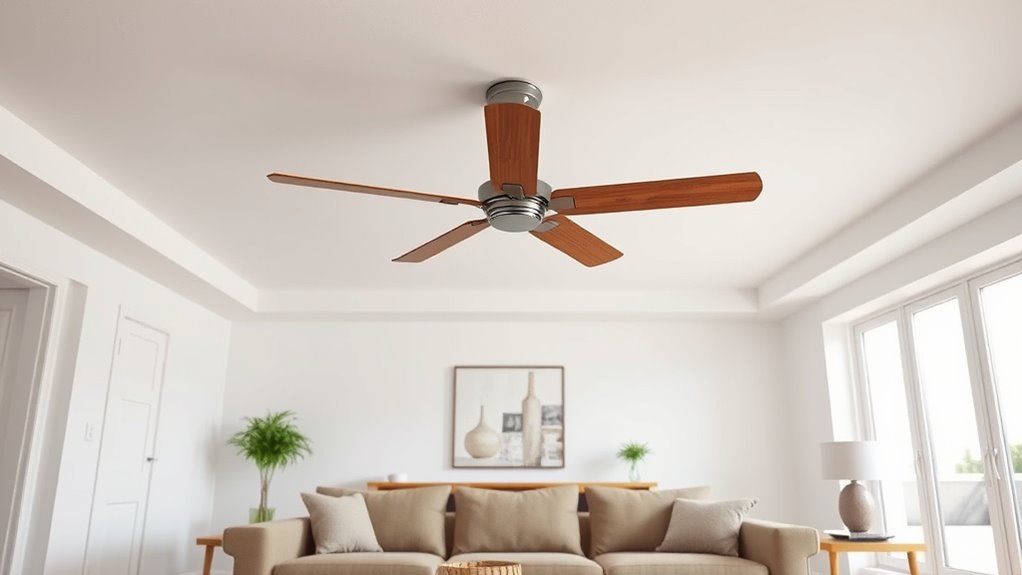
Proper clearance around your ceiling fan is essential for both safety and performance. You should guarantee at least 7 feet from the floor to the lowest blades in residential spaces, or 8 feet for industrial or commercial fans. This prevents accidental contact and reduces injury risks. Maintain an 8 to 10-inch gap between the blades and the ceiling to optimize airflow and minimize wobbling or noise. Also, keep at least 18 inches of space from walls or obstructions to prevent blade interference and ensure proper air circulation. Follow local building codes and manufacturer guidelines for specific clearance requirements. Proper spacing not only enhances safety but also improves energy efficiency, reduces vibration, and extends the fan’s lifespan by allowing it to operate smoothly and effectively. Adhering to safety clearance guidelines is crucial for preventing accidents and ensuring optimal fan performance.
Decide on Control Options and Additional Features
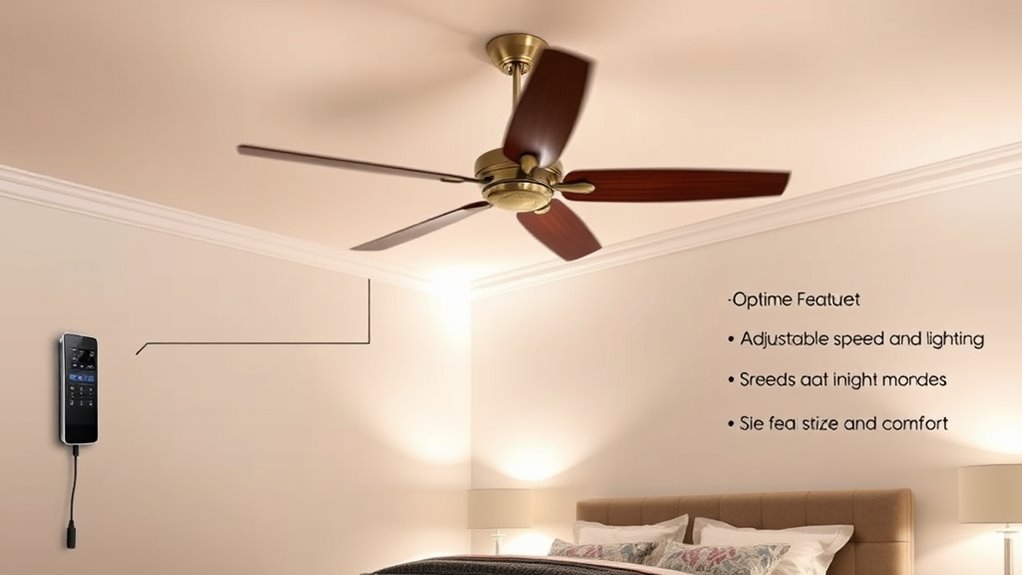
Selecting the right control options and additional features for your ceiling fan depends on your room layout, lifestyle, and preferences. Consider how you’ll use your fan daily and whether convenience or advanced features matter most.
- Wall controls offer fixed, reliable access, ideal for traditional setups.
- Remote controls provide convenience, especially for high or hard-to-reach fans.
- Pull chains are simple and budget-friendly but less practical for high ceilings.
- Control modules and smartphone apps give advanced customization and remote access, perfect for tech-savvy users.
- Additional features like light dimming, timers, and reversible blades enhance functionality and energy efficiency.
Think about ease of use, installation complexity, and your budget to choose the best control system for your needs.
Follow Maintenance and Safety Practices for Longevity

To guarantee your ceiling fan operates safely and lasts for years, regular maintenance and safety checks are essential. Dust your fan blades every 1–2 weeks using a microfiber cloth or long-handled duster, working from the center outward to prevent spreading dust. Use gentle cleaning solutions like soapy water, avoiding harsh chemicals that could damage finishes. Periodically check the motor for lubrication needs—many modern fans have sealed motors, but if applicable, apply a few drops of oil to reduce friction. Tighten all screws, bolts, and mounting hardware regularly to prevent wobbling or loosening. Inspect blades for cracks or warping and replace damaged ones promptly. Schedule professional inspections every 12–18 months for ideal, motor health, and efficiency. Regular maintenance also helps identify early signs of wear that could lead to safety hazards if left unchecked.
Frequently Asked Questions
How Do I Measure My Room Accurately for Fan Sizing?
To measure your room accurately, start by using a tape measure or laser device to find the length and width in feet. For irregular shapes, divide the space into rectangles, measure each, and add the areas. Don’t forget to measure the ceiling height, especially if it’s over 8 feet, to determine if you need a longer downrod. Precise measurements make certain you select a fan that fits well and circulates air effectively.
What Fan Size Is Best for Vaulted or Sloped Ceilings?
For vaulted or sloped ceilings, choose a fan with a blade span suited to your room size—29-36 inches for small spaces, up to 50-54 inches for larger rooms. Use a minimum 12-inch downrod to position the fan properly and guarantee good airflow. Check if your ceiling’s pitch requires a sloped ceiling adapter, especially for steep slopes. Select fans designed for these ceilings to maximize efficiency and safety.
Can I Install a Larger Fan in a Small Room?
You can install a larger fan in a small room, but you should be cautious. Oversized fans can cause discomfort with excessive airflow, noise, and visual dominance. They may also waste energy and disrupt air circulation balance. To avoid these issues, consider high ceilings or adjust fan speed settings. Usually, sticking to recommended sizes for your room’s square footage guarantees comfort, efficiency, and aesthetic harmony.
How Do I Determine the Right CFM for My Space?
Imagine the gentle breeze of a fan swirling through your space, keeping you comfortable. To find the right CFM, measure your room’s square footage—length times width. For small rooms, aim for around 1,000 CFM; medium rooms need 1,500 to 4,500 CFM; large spaces require 2,300 to 6,500 CFM. Match your room size with CFM to avoid stuffiness or drafts, ensuring perfect airflow.
Are There Specific Fans Designed for Outdoor or Humid Areas?
You’ll find fans specifically designed for outdoor or humid areas, labeled as “Damp Rated” or “Wet Rated.” Damp Rated fans work well in covered patios or bathrooms, resisting moisture but not direct water. Wet Rated fans handle direct rain, ideal for open outdoor spaces like pergolas. Look for weather-resistant materials, sealed motors, and certifications like UL Wet Rated to guarantee safety and durability in harsh environments.
Conclusion
Choosing the right ceiling fan isn’t just about size; it’s about creating comfort and efficiency in your space. Some believe bigger fans always cool better, but that’s not true—matching fan size to your room’s specifics matters most. By considering airflow, noise, and safety, you guarantee your fan works seamlessly. When you select wisely, you might even find that a well-chosen fan can boost your room’s ambiance and energy savings—proving that proper matching truly makes all the difference.
